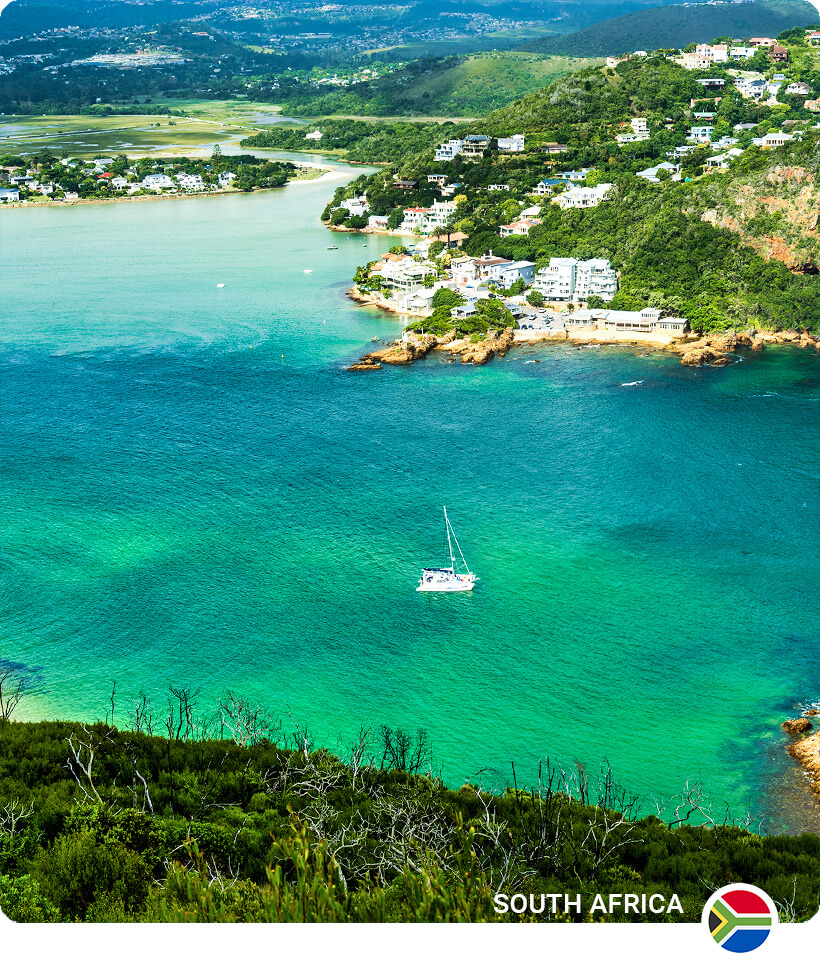Cape Town captivates! Famous for its breathtaking blend of majestic nature – from the iconic Table Mountain to stunning turquoise beaches, and vibrant city life, it’s a top South Africa travel destination. Planning the perfect trip requires insider knowledge, and that’s exactly what this guide offers.
Consider this blog post your essential Cape Town travel guide and local briefing. We delve into the must-see sights like Table Mountain and the V&A Waterfront, explore stunning coastal routes including the Cape Peninsula and Clarence Drive (R44), visit the nearby Winelands, and experience the colourful Bo-Kaap. More importantly, we share crucial travel tips, practical information (transport, costs, safety for your visit to Cape Town), and reveal those local secrets and hidden gems to help you explore the Mother City with confidence and authenticity.
Experience Cape Town visually before you go! This blog post pairs perfectly with our detailed video travel guide. Watch below to see these stunning locations brought to life with spectacular footage and insightful commentary – it’s an essential visual planning tool for your trip.
1. Table Mountain: Cape Town's Unmissable Icon
Dominating the skyline, Table Mountain is Cape Town’s most iconic landmark and an essential experience for any visitor. This omnipresent guardian of the “Mother City” is one of the New 7 Wonders of Nature and part of a UNESCO World Heritage site, holding deep significance for locals and offering breathtaking majesty for travellers.
 Night view of Table Mountain watching over the brightly lit city of Cape Town
Night view of Table Mountain watching over the brightly lit city of Cape Town
Note: The photos throughout this guide were captured during the filming of our accompanying video. If you’re interested in licensing these images, please find links to our portfolio at the end of this post.
Nature & Geology
Beyond its dramatic, flat-topped silhouette formed over millions of years, the mountain is a biodiversity hotspot within the Table Mountain National Park. It boasts unique Fynbos vegetation (part of the Cape Floral Kingdom) and is home to thousands of plant species – keep an eye out for the small, rock-dwelling Dassie!Reaching the Summit: Cable Car vs. Hike
There are two main ways to reach the top:
-
Table Mountain Aerial Cableway: The most popular option whisks you to the summit in about 5 minutes via rotating cars with 360-degree views. Crucially: Check the official website beforehand as operations are highly weather-dependent (especially wind) and can be suspended. Booking tickets online is highly recommended to avoid queues, especially during peak season.
-
Hiking Trails: For the adventurous, several trails lead up. Popular options range from the direct but strenuous Platteklip Gorge (mostly rock steps, 2-3 hrs) to the scenic, forested Skeleton Gorge (starts in Kirstenbosch, includes ladders/scrambling, 3.5-5 hrs), and the more technical India Venster (requires scrambling, not for novices, 2-3 hrs). Given the changeable weather and terrain, guided hikes are strongly recommended for safety and insights into the environment.
On Top of the World
The summit plateau offers incredible panoramic views over the city, harbour, Robben Island, and the Cape Peninsula. Explore well-maintained pathways, join free guided walks departing from the Upper Cable Station, or head towards Maclear’s Beacon (the highest point). Thrill-seekers can even book the Table Mountain Abseil. Restaurants and cafes provide spots to relax and soak in the vistas.
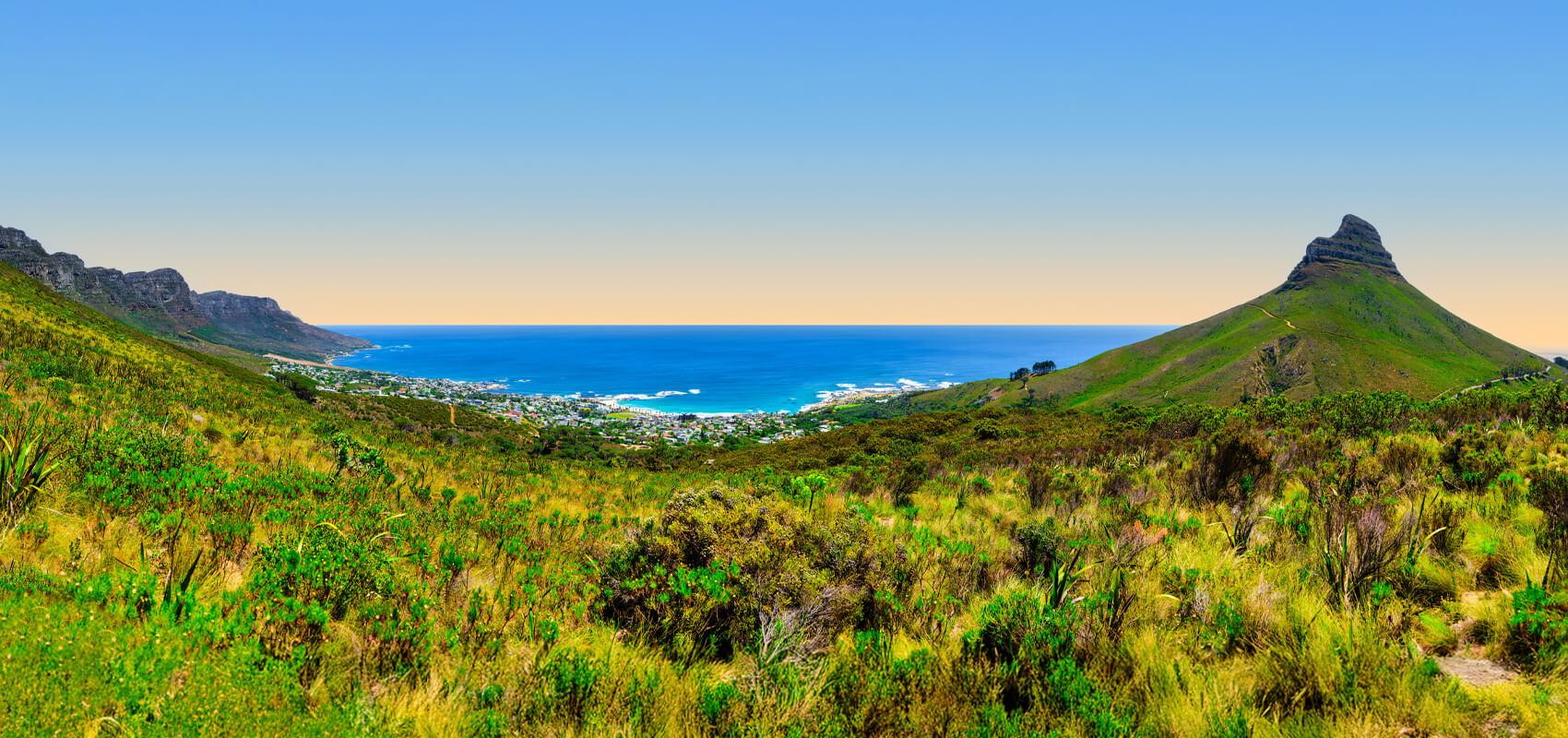 Panoramic view from the top of Table Mountain featuring the 12 Apostles, Lion’s Head, and the Atlantic Ocean.
Panoramic view from the top of Table Mountain featuring the 12 Apostles, Lion’s Head, and the Atlantic Ocean.
Safety is Paramount
Respect the mountain’s rapidly changing weather. Always check the forecast specifically for the summit before setting out.
-
Hiking Safety: Never hike alone (aim for groups of 4+), inform someone of your route/timing, wear layers (including warm/waterproof gear), carry ample water (2L+ pp) and snacks, use a map, have a charged phone (patchy signal), and stay on marked paths. Use emergency numbers if needed (TMNP Emergency: 086 110 6417).
-
General Safety: Be aware of your surroundings, especially in quieter areas. Avoid displaying valuables.
Best Views of the Mountain
For fantastic photos of Table Mountain itself, head to adjacent Signal Hill or Lion’s Head. Signal Hill is particularly popular for sunset picnics and offers panoramic Atlantic views.
Experiencing Table Mountain, by cable car or trail, is fundamental to understanding Cape Town. Its presence and the views from the top are truly unforgettable.
Important Links:
- Official Cableway Info & Booking: Table Mountain Aerial Cableway
- National Park Information: Table Mountain National Park (SANParks)
- Hiking Safety Guidelines: SANParks Hiking Safety
2. Cape Town's Playground: Exploring the Vibrant V&A Waterfront
Immerse yourself in the energetic heart of Cape Town at the Victoria & Alfred (V&A) Waterfront. More than just a mall, this iconic destination is a dynamic neighbourhood blending history, culture, entertainment, and stunning natural beauty, all set against the backdrop of Table Mountain and the Atlantic Ocean.
A Historic Harbour Reimagined
Built around South Africa’s oldest working harbour (dating back to 1654), the V&A was redeveloped from the 1980s onwards, carefully preserving heritage buildings. This blend of maritime history and modern energy is unique – you can still watch harbour life, including the resident Cape Fur Seals often seen basking near the water.
Shopping: Global Brands to Local Crafts
Shopping caters to all tastes. The main Victoria Wharf Shopping Centre houses over 450 stores, from luxury labels to South African retailers. For unique local finds, don’t miss The Watershed, focusing on African design and crafts from over 150 makers – perfect for meaningful souvenirs. Other areas like Alfred Mall and the Clock Tower precinct offer more boutique options.
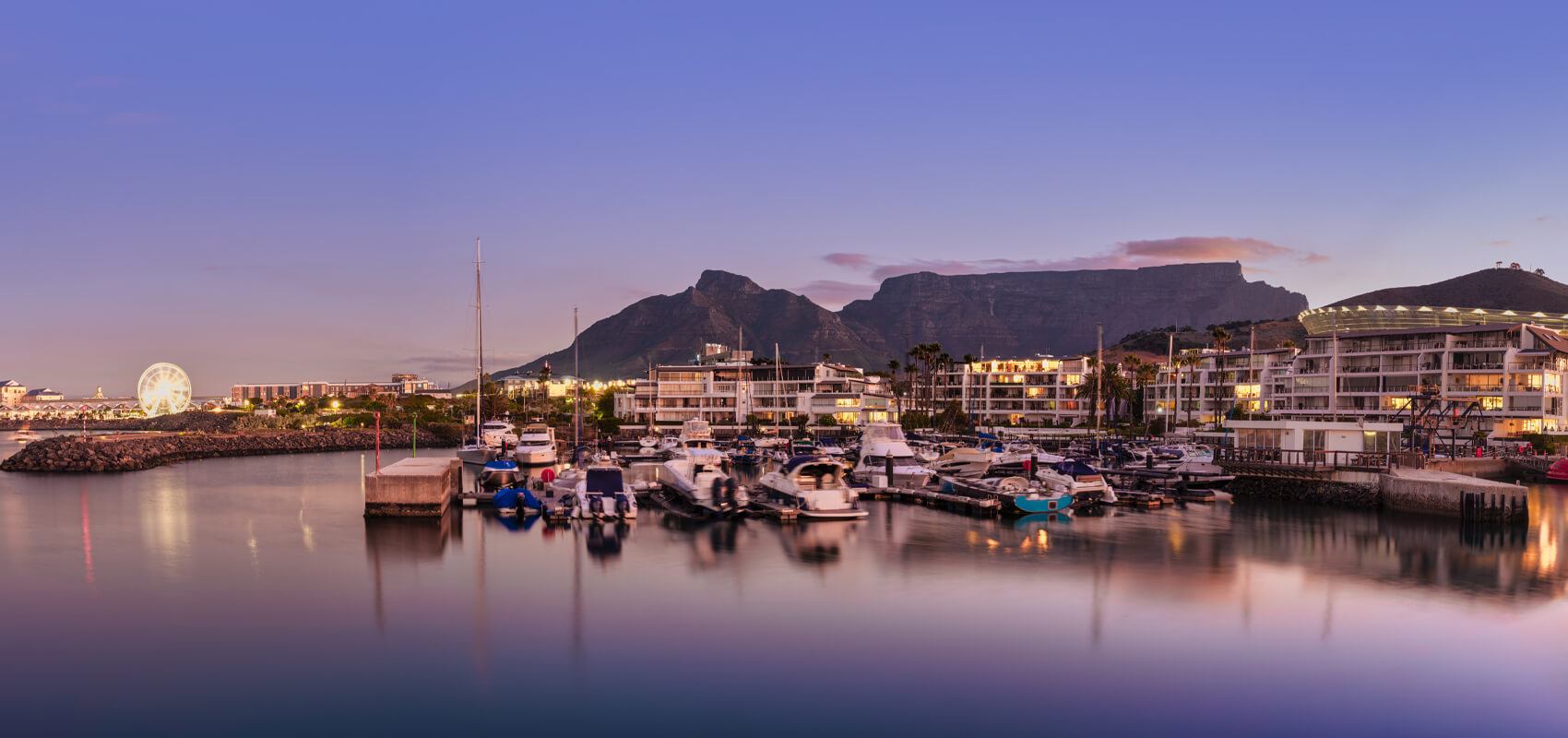 Stunning evening view of the V&A Waterfront under glowing lights with Table Mountain standing tall in the background.
Stunning evening view of the V&A Waterfront under glowing lights with Table Mountain standing tall in the background.
Dining Delights
Hundreds of eateries offer diverse options. Find everything from world-class fine dining with stunning views (like Pier or Baia) to popular casual spots (like Willoughby & Co for sushi or Den Anker for mussels) and buzzing food markets (like the V&A Food Market or the weekend Oranjezicht City Farm Market). Many restaurants boast harbour or mountain views.
Top Attractions & Entertainment
Beyond shopping and dining, the V&A is packed with activities:
- Two Oceans Aquarium: A world-class facility showcasing marine life from the Atlantic and Indian Oceans, including kelp forests, sharks, and penguins, with a focus on conservation.
- Zeitz Museum of Contemporary Art Africa (MOCAA): Located in a stunningly repurposed grain silo, this is the world’s largest museum of contemporary African art. The architecture itself is a major draw.
- Boat Trips: Numerous options launch from the harbour, including sunset cruises, seal watching trips, harbour tours, and the essential ferry to Robben Island (book well in advance via the Robben Island Gateway).
- The Cape Wheel: A large observation wheel offering panoramic views over the Waterfront, city, and Table Mountain.
- Live Entertainment: The Waterfront often buzzes with street performers and events at the Amphitheatre.
Practical Information
- Getting There: Easily accessible via the Hop-On Hop-Off bus (Stop 1), MyCiTi bus routes, walking from the city centre (approx. 15 mins), or driving (ample paid parking).
- Getting Around: Pedestrian-friendly; grab a map. Water taxis operate on the canals.
- Operating Hours: Core shops are typically 9 am-9 pm, but attractions/restaurants vary. Check the official V&A website for current times.
- Safety: Generally very safe with visible security. Standard precautions against pickpocketing are advised.
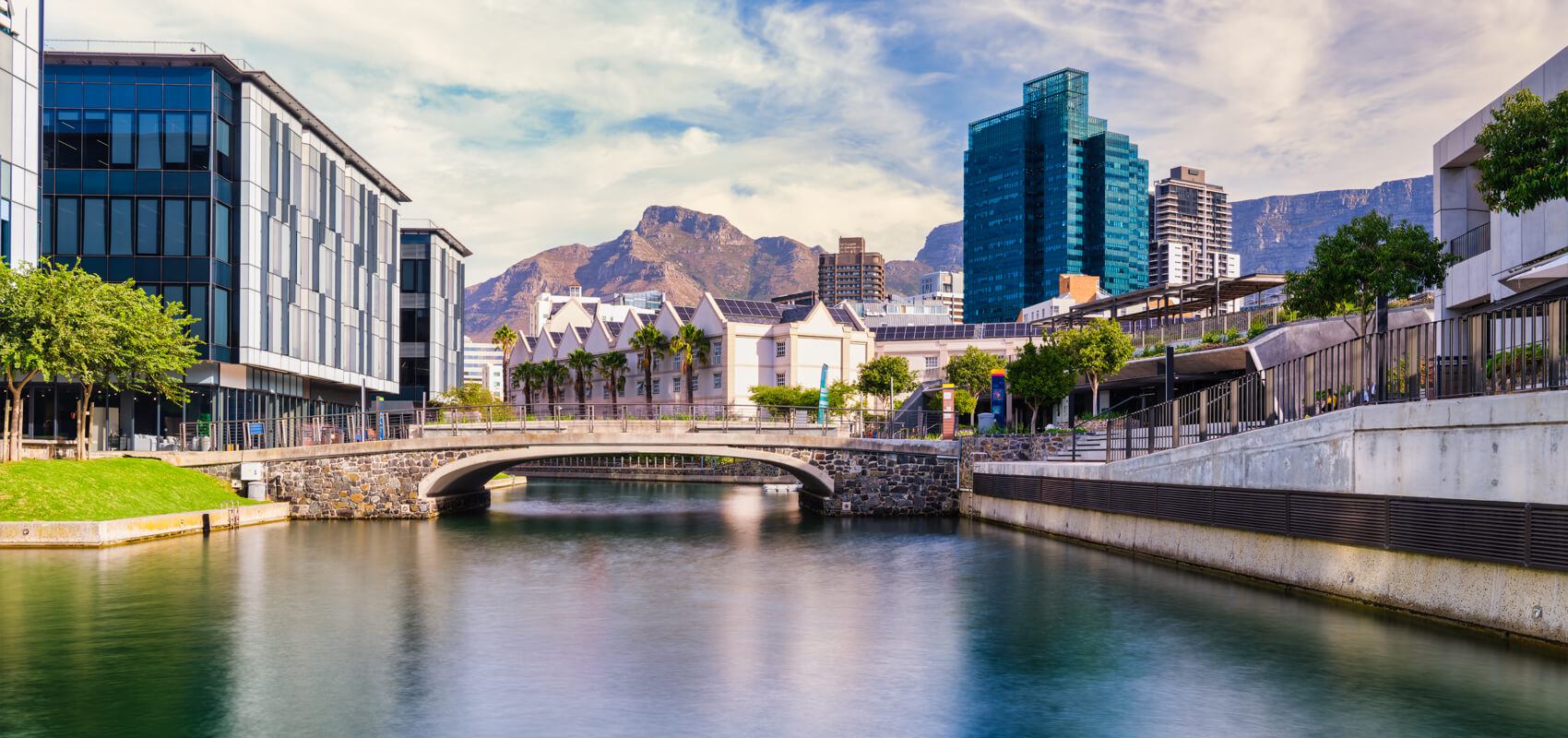 Cape Town’s iconic V&A Waterfront and tranquil canals, set against the backdrop of the city’s urban landscape.
Cape Town’s iconic V&A Waterfront and tranquil canals, set against the backdrop of the city’s urban landscape.
The V&A Waterfront is a destination in itself, easily filling a day or more with exploration, entertainment, and soaking up the vibrant atmosphere where the city meets the sea.
Essential Links:
- Official Website & Map: V&A Waterfront
- Marine Life Exploration: Two Oceans Aquarium
- Contemporary African Art: Zeitz MOCAA
- Historic Island Tours: Robben Island Museum (Ferry Booking)
- Panoramic Views: The Cape Wheel
3. Atlantic Seaboard: Cape Town's Riviera - Sunsets, Style and Scenery
Stretching along Cape Town’s western edge where mountains meet the ocean lies the famed Atlantic Seaboard, often called Cape Town’s Riviera. This glamorous coastline encompasses exclusive neighbourhoods known for breathtaking views, world-class beaches, a vibrant social scene, and unforgettable sunsets – a perfect blend of natural beauty and sophisticated lifestyle.
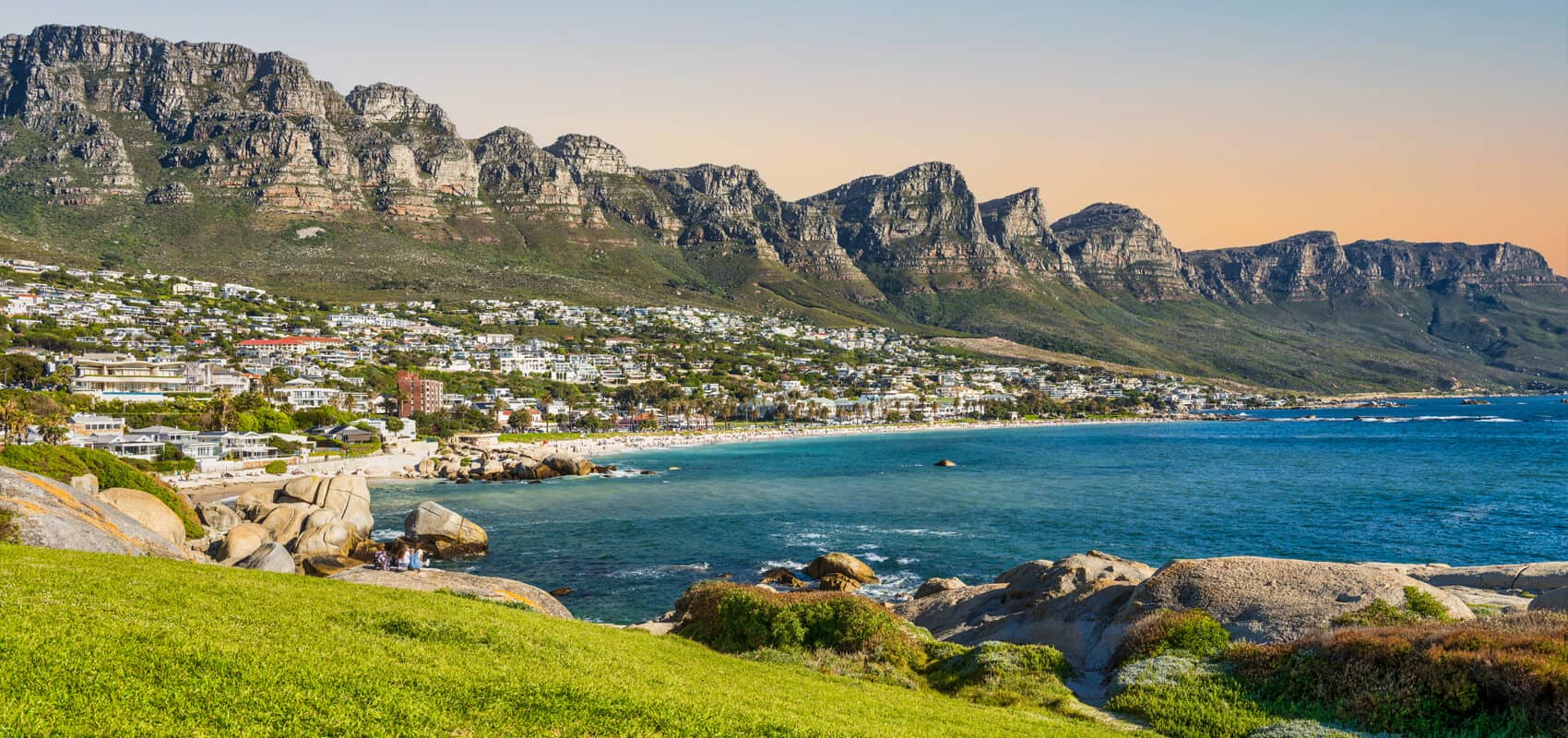 Breathtaking panorama featuring the majestic Twelve Apostles mountain, Camps Bay below and the 4th beach
Breathtaking panorama featuring the majestic Twelve Apostles mountain, Camps Bay below and the 4th beach
A Journey Along the Coastline
Driving the winding Victoria Road offers stunning vistas. Key areas include:
- Green Point & Mouille Point: Near the V&A, featuring DHL Stadium, the lovely Green Point Urban Park, and the Mouille Point promenade with its lighthouse.
- Sea Point: A vibrant local hub defined by its bustling Promenade – kilometres of paved pathway perfect for walking, jogging, and cycling, alongside the popular Sea Point Pavilion swimming pools (filled with filtered seawater). Main Road behind it offers diverse eateries and shops.
- Clifton: Globally renowned for four beautiful beach coves with pristine white sand and turquoise (but cold!) water, separated by granite boulders. Clifton 4th is the most famous and holds Blue Flag status.
- Camps Bay: Perhaps the most famous spot, known for its long, palm-fringed beach set against the stunning Twelve Apostles mountain range. The beachfront strip buzzes with trendy restaurants and bars perfect for watching sunsets. A tidal pool offers safer swimming.
- Bakoven: A quieter, residential area just south of Camps Bay, offering small, secluded coves like Beta Beach for tranquil escapes.
- Llandudno: A more remote, exclusive enclave with a beautiful, wide beach popular with surfers (limited facilities/parking).
Activities & Unforgettable Sunsets
Beyond beach-hopping, enjoy hiking trails like the Pipe Track or Kasteelspoort, or try tandem paragliding from Signal Hill. Water sports like SUP and kayaking are popular. Experiencing an Atlantic Seaboard sunset is absolutely essential – find a spot on a beach, a viewpoint, or a chic bar and watch the sun dip into the ocean.
 Panoramic image of Clifton Beach with sparkling turquoise beach, and Lion’s Head rising gracefully in the ditance.
Panoramic image of Clifton Beach with sparkling turquoise beach, and Lion’s Head rising gracefully in the ditance.
Practical Tips for Your Visit
- Transport: Driving offers flexibility, but parking near Clifton and Camps Bay is extremely difficult in peak season. Consider MyCiTi buses or ride-sharing services.
- Wind: Be prepared for the ‘Cape Doctor’ (south-easterly wind), especially in summer afternoons. Clifton 4th often offers more shelter.
- Ocean: The Atlantic is cold year-round! Tidal pools (like in Sea Point and Camps Bay) provide safer, slightly warmer swimming. Be aware of currents.
- Safety: Generally safe in busy areas during the day. Exercise standard precautions, avoid leaving valuables visible, and be cautious after dark or in quieter spots.
- Accommodation: Ranges from luxury villas in Clifton/Camps Bay to hotels and apartments in Sea Point/Green Point.
- The Atlantic Seaboard embodies Cape Town’s glamorous side – ideal for stunning beaches, great food, incredible views, and some of the world’s most spectacular sunsets.
Helpful Links for Planning:
- Official Area Information: Discover Cape Town’s Atlantic Seaboard (Cape Town Tourism)
- Public Pool Complex: Sea Point Swimming Pool (City of Cape Town)
4. Cape Peninsula: Explore Cape Town's Stunning Coastal Paradise
Prepare for one of the world’s most breathtaking drives – the Cape Peninsula tour. This journey along Cape Town’s southern fringes is an absolute must-do, where rugged mountains meet two oceans within the Table Mountain National Park UNESCO World Heritage Site, offering scenic beauty, rich history, wildlife encounters, and charming coastal villages. Driving the loop clockwise (starting on the False Bay side) often works best for views and potential sunset timing.
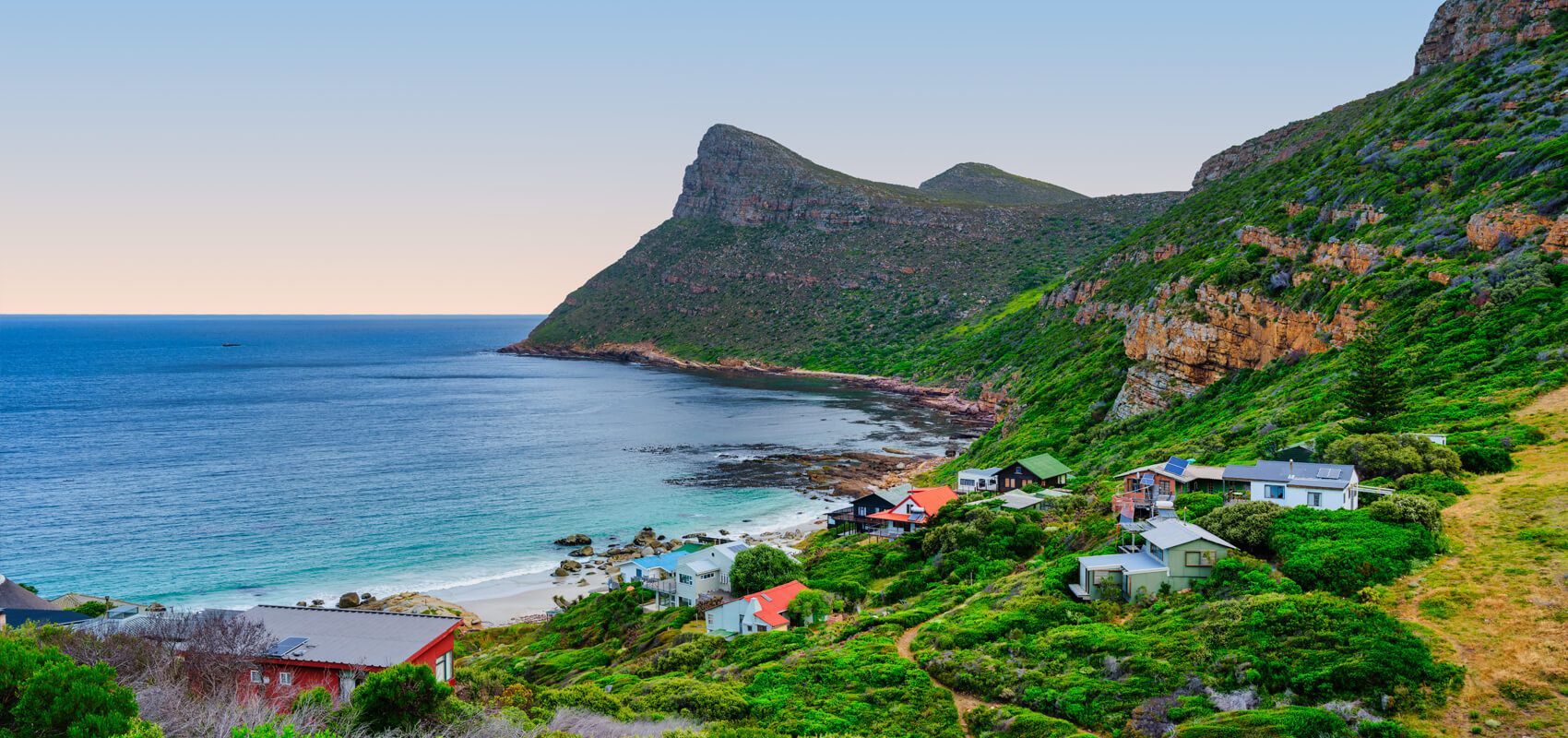 Smitswinkel Bay on the Cape Peninsula bathed in warm sunset colors
Smitswinkel Bay on the Cape Peninsula bathed in warm sunset colors
Starting the Scenic Loop (False Bay Side)
Begin in Muizenberg, famous for its colourful Victorian bathing boxes and gentle waves at ‘Surfer’s Corner’. Nearby St. James boasts similar iconic huts and a sheltered tidal pool. Continue to bohemian Kalk Bay, exploring its vibrant harbour, eclectic shops, galleries, and bustling eateries like the Brass Bell. Then comes historic Simon’s Town, South Africa’s main naval base, with well-preserved Victorian architecture and maritime museums.
Boulders Beach: Penguin Encounters
Just south of Simon’s Town lies the unique Boulders Beach, home to a colony of endangered African penguins. Wooden walkways allow close-up observation as they waddle among the granite boulders. You can even swim in a separate, sheltered cove sometimes frequented by the penguins. Remember this is a protected area (entry fee required), and it’s crucial to maintain distance – never touch or feed the penguins.
 Charming African penguins waddling on the sandy shores of Boulders Beach in the Cape Peninsula.
Charming African penguins waddling on the sandy shores of Boulders Beach in the Cape Peninsula.
Smitswinkel Bay: A Secluded Hidden Gem
For those seeking a true hidden gem mentioned in our video, consider Smitswinkel Bay. Located just a short drive from Simon’s Town and nestled under Swartkop Peak, this secluded beach requires a scenic hike down to reach. Your reward is tranquil, calm waters with rocky pools perfect for relaxing, while adventurous visitors might explore the nearby reef through diving or snorkeling.
Cape Point: Edge of the Continent
The dramatic climax is the Cape of Good Hope Nature Reserve within Table Mountain National Park. This wild, windswept reserve features rugged cliffs, unique fynbos, diverse wildlife (ostriches, antelope, zebra – and watch out for baboons: never feed them, secure your car/belongings!), and stunning ocean vistas. Hike or take the Flying Dutchman Funicular to the old lighthouse for panoramic views, walk down to the Cape of Good Hope (Africa’s southwesternmost point), or explore secluded beaches. Numerous hiking trails are available. Allow several hours to explore properly; entry fees apply (check SANParks rates).
The Atlantic Return via Chapman's Peak
The absolute highlight is Chapman’s Peak Drive, an engineering marvel carved into cliffs between Noordhoek and Hout Bay offering breathtaking views. It’s a toll road; always check its operational status online before heading out, as it can close due to weather. Emerge into Noordhoek, known for its long sandy beach (popular for horse riding), before reaching Hout Bay. This bustling town centres around a working fishing harbour. Consider a boat trip to see the Duiker Island seal colony or enjoy famously fresh fish and chips at local spots like Snoekies or Fish on the Rocks.
Tips for Your Peninsula Adventure
- Time: Dedicate a full day (8-9+ hours).
- Direction: Clockwise is generally recommended.
- Transport: Self-driving offers flexibility; guided tours are also available.
- Safety: Lock cars, hide valuables. Be extremely cautious of baboons (do not feed!). Be aware of ocean conditions. Avoid driving after dark if possible.
- Costs: Budget for Chapman’s Peak toll and conservation fees at Cape Point & Boulders. Bring cash for potential parking attendants.
- Preparation: Check weather, wear comfy shoes, bring layers, sun protection, water, and a camera!
The Cape Peninsula drive immerses you in the wild, beautiful, and historic spirit of Cape Town.
Helpful Links:
- Park Information: Table Mountain National Park (SANParks)
- The Southwestern Tip: Cape Point Official Site
- Penguin Encounters: Boulders Penguin Colony (SANParks)
- The Scenic Drive: Chapman’s Peak Drive Official Site
5. Cape Town's Vibrant Heart: Exploring the City Bowl & Bo-Kaap
Let’s dive into the colourful and dynamic heart of Cape Town: the City Bowl and the historic Bo-Kaap neighbourhood. Nestled in a natural amphitheatre formed by Table Mountain, Devil’s Peak, Lion’s Head, and Signal Hill, this central area pulses with energy, history, culture, and offers a unique blend of urban buzz and rich heritage. It’s home to bustling streets like Long Street, the tranquil Company’s Garden, and poignant historical sites like the District Six Museum.
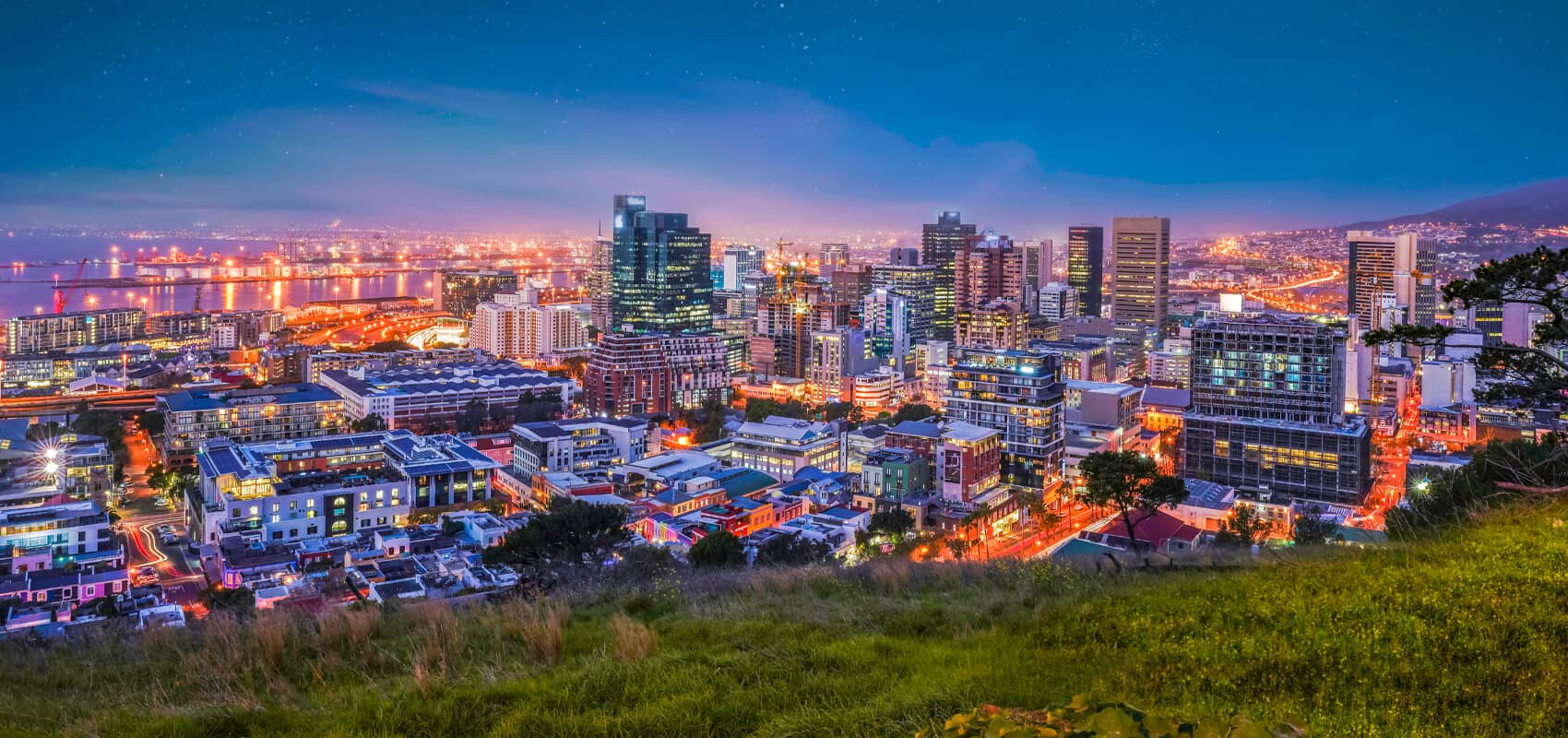 Aerial shot of Cape Town’s City Bowl stretching towards the harbor seen from Bo-Kaap.
Aerial shot of Cape Town’s City Bowl stretching towards the harbor seen from Bo-Kaap.
Adjacent to the city centre lies the Bo-Kaap. Famous for its brightly coloured houses lining steep, cobblestone streets, this area (formerly the Malay Quarter) is a feast for the eyes and a centre of Cape Malay culture.
Highlights Not to Miss
- Bo-Kaap Wander: Stroll through streets like Chiappini and Rose Street to admire the vibrant, photogenic houses. Remember these are homes – please be respectful (ask before photographing residents).
- Taste of Cape Malay: Sample authentic Cape Malay food at restaurants like Bo-Kaap Kombuis or Biesmiellah. For spices and local flavour, visit Atlas Trading Company on Wale Street.
- Company’s Garden: Relax in this historic green oasis in the city centre.
- Museums: Explore local history at the Bo-Kaap Museum or the essential District Six Museum.
- Hiking Views: Hike nearby Lion’s Head or Signal Hill for panoramic City Bowl and harbour views.
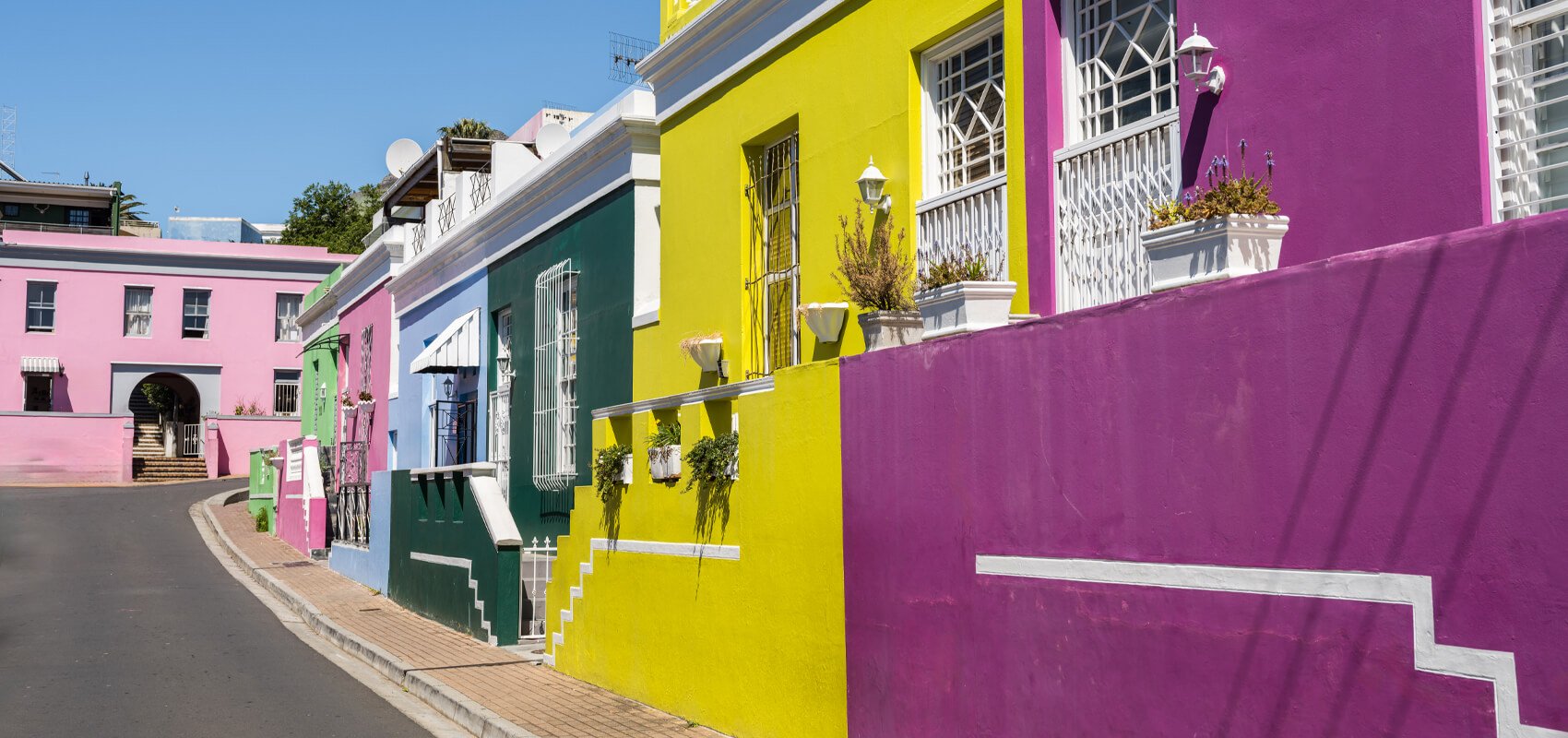 Vibrant, colorful houses along a cobblestone street in the historic Bo-Kaap.
Vibrant, colorful houses along a cobblestone street in the historic Bo-Kaap.
Helpful Tips for Your Visit
- Getting Around: The City Bowl is walkable; Bo-Kaap is a short walk from the centre. Ride-sharing services are readily available.
- Best Time for Bo-Kaap: Visit during daylight for the best photos and atmosphere.
- Parking: Can be challenging in Bo-Kaap’s narrow streets; consider walking or using ride-sharing/taxis.
- Etiquette: Dress modestly if visiting mosques. Be mindful of noise, especially during prayer times, and respect residents’ privacy.
- Safety: Exercise standard urban precautions, especially after dark. Keep valuables secure.
The City Bowl and Bo-Kaap offer a vibrant cultural tapestry unlike anywhere else in Cape Town.
Helpful Links:
- Explore Cape Town Activities: Cape Town Activities & Attractions)
- Bo-Kaap Museum Info: Iziko Museums Visitor Information)
- District Six History: District Six Museum Official Site)
- Hiking Information: Table Mountain National Park Trails)
6. Sip & Savour: A Taste of the Constantia Wine Region
Just an 18-minute picturesque drive from Cape Town’s city centre transports you to the Constantia Wine Region. Nestled beneath Table Mountain’s eastern slopes, this verdant valley isn’t just another stop – it’s the birthplace of South African wine. As the country’s oldest wine region (dating back to 1685), Constantia offers a captivating blend of history, stunning landscapes, award-winning wines, and exceptional food.
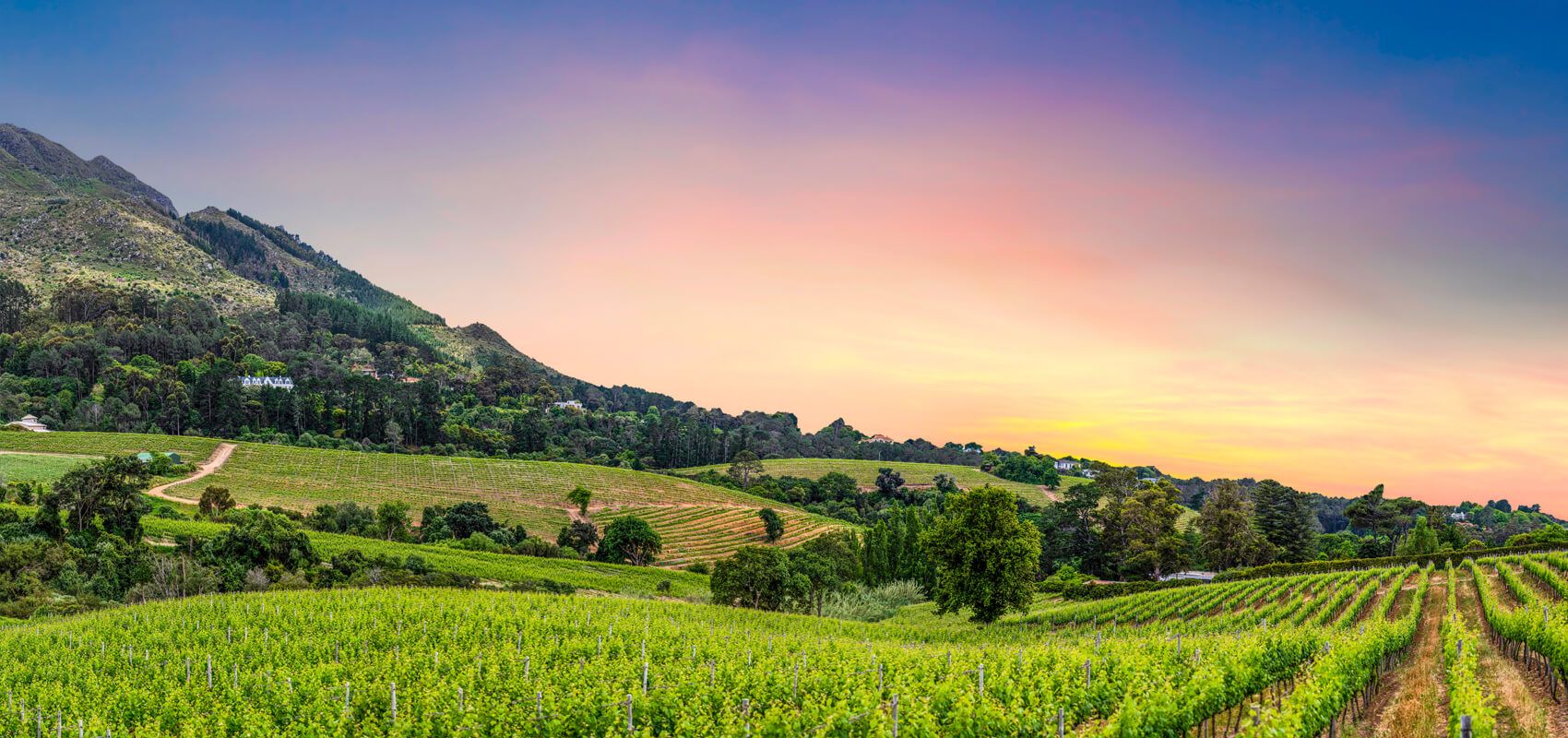 Stunning vista of Constantia Valley’s vineyard-covered slopes, surrounded by serene rolling hills and dramatic mountain.
Stunning vista of Constantia Valley’s vineyard-covered slopes, surrounded by serene rolling hills and dramatic mountain.
A Legacy of Wine: History & Terroir
The story began in 1685 when Governor Simon van der Stel established his farm, Constantia, recognizing the area's potential. The valley's unique terroir, with granite soils and cooling sea breezes, proved ideal, especially for aromatic whites and the legendary sweet Vin de Constance, famed across 18th/19th-century Europe.Iconic Constantia Estates
- Groot Constantia: South Africa’s oldest wine-producing estate. Explore the historic Cape Dutch Manor House (Iziko museum), Cloete Cellar, and enjoy tours/tastings. Restaurants: Jonkershuis & Simon’s.
- Klein Constantia: Famous for reviving the legendary Vin de Constance. Tasting this sweet wine is a highlight. Also known for elegant Sauvignon Blanc. Booking recommended.
- Buitenverwachting: Meaning “Beyond Expectation,” this beautiful estate offers renowned Sauvignon Blanc, picnics (book ahead), and refined dining.
- Constantia Glen: A family-owned boutique estate high on Constantia Nek with breathtaking views. Known for cool-climate Sauvignon Blanc and Bordeaux blends. Offers platters and a restaurant.
- Steenberg Vineyards: The Cape’s first registered farm (1682), now blending history with luxury. Offers acclaimed MCC (sparkling wine), Sauvignon Blanc, a hotel, spa, golf course, and top restaurants (Tryn, Bistro Sixteen82).
- Beau Constantia: A modern estate perched on Constantia Nek with stunning architecture and views. Known for quality wines and the acclaimed Chefs Warehouse tapas restaurant.
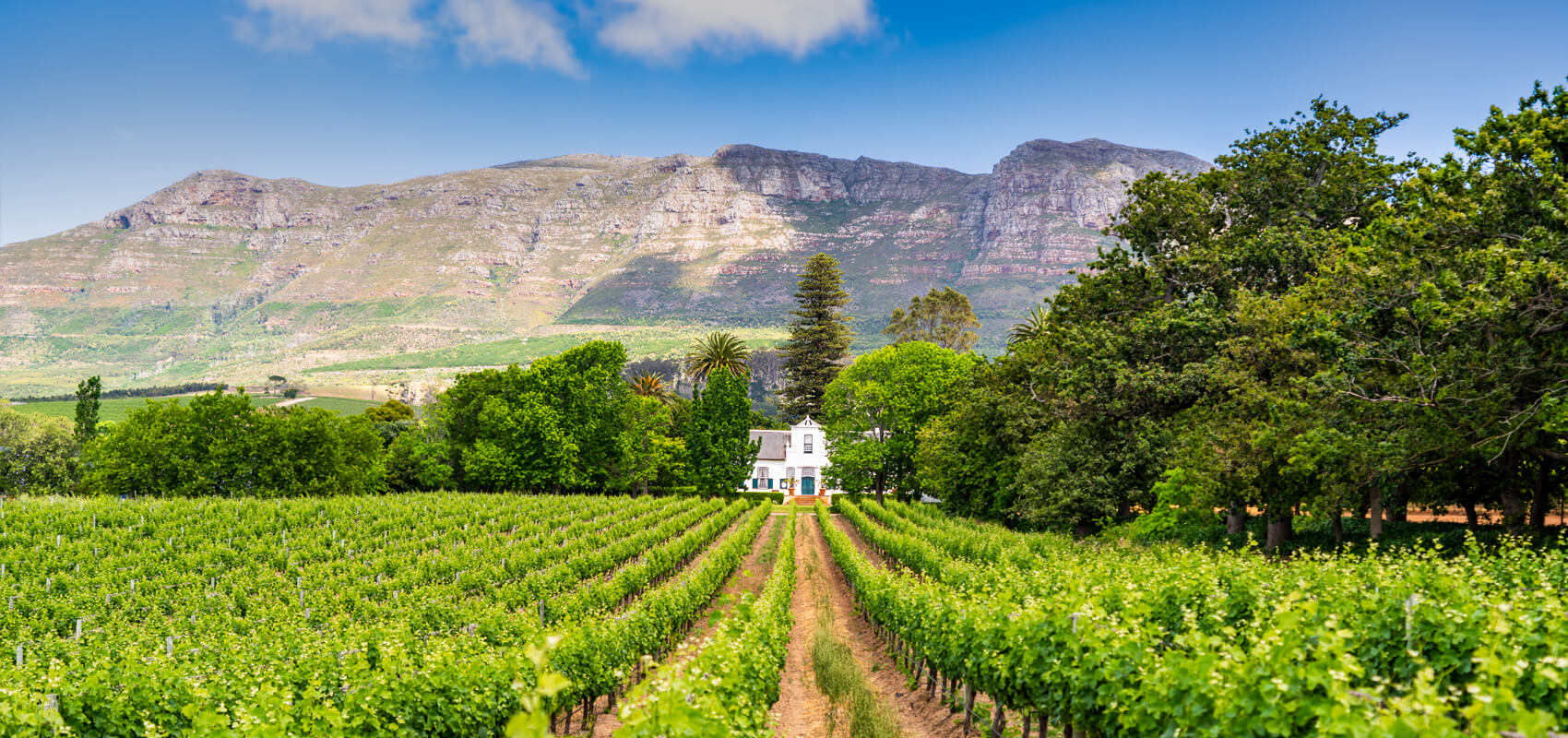 Vineyards extending gracefully towards Cape-Dutch farmhouse of Buitenverwachting in the scenic Constantia Valley.
Vineyards extending gracefully towards Cape-Dutch farmhouse of Buitenverwachting in the scenic Constantia Valley.
Planning Your Constantia Wine Visit
- Getting Around: Planning transport is key for wine tasting. Options include self-drive (designated driver needed), ride-sharing (Uber/Bolt - potentially less reliable between estates), the City Sightseeing Purple Wine Tour bus (connects from the Blue Route at Constantia Nek, serves Groot Constantia, Eagles’ Nest, Beau Constantia), or guided wine tours.
- Bookings: Essential! Book tastings, tours, picnics, and especially restaurants well in advance, particularly on weekends/peak season. Check estate websites for booking methods (some use Dineplan, others direct contact).
- Timing: Allow 2-3 hours per estate for a relaxed tasting/lunch. Plan 2-3 estates for a full day. Check individual opening hours.
- Beyond Wine: Combine your visit with hiking in nearby Cecilia Forest or Constantia Nek, or explore the adjacent, world-renowned Kirstenbosch National Botanical Gardens.
Helpful Links:
- Constantia Wine Route: Constantia Wine Route Official Site
- Groot Constantia: Groot Constantia Official Site
- Klein Constantia: Klein Constantia Official Site
- Buitenverwachting: Buitenverwachting Official Site
- Constantia Glen: Constantia Glen Official Site
- Steenberg Vineyards: Steenberg Farm Official Site
- Beau Constantia: Beau Constantia Official Site
- Kirstenbosch Gardens: SANBI Kirstenbosch Official Site
7. Cape Winelands Day Trip: Vineyards, History & Luxury
Beyond Constantia, the broader Cape Winelands offer another captivating experience for tourists, typically reached via an hour’s scenic drive (approx. 50km) northeast of Cape Town. Immerse yourself in a region of majestic mountains, lush vineyards, and charming Cape Dutch farmsteads, blending stunning landscapes with rich cultural heritage and exceptional wine production. You can explore various estates, learn about winemaking, and enjoy wine tastings. Here are the estates highlighted in our video tour:
 Stunning view of the elegant fountain at Vergelegen Estate, surrounded by lush gardens in the Cape Winelands.
Stunning view of the elegant fountain at Vergelegen Estate, surrounded by lush gardens in the Cape Winelands.
Featured Wineland Estates
- Delaire Graff Estate: Nestled in the heart of the Winelands, this estate impresses with its Cape Dutch architecture and spectacular 360° panoramas. Explore boutique stores featuring over 400 pieces of art and sculptures. It boasts a state-of-the-art winery, exclusive lodges (each with private pools and stunning views), a destination spa, meticulously maintained vineyards and gardens, and two exceptional restaurants pairing exquisite cuisine with the estate’s wines.
- Neethlingshof Estate: A historic wine farm with roots dating back to 1692. Notably, Nelson Mandela attended a press dinner here in 1991. Neethlingshof practices sustainable winemaking and is committed to organic and vegan-friendly wines. You can pair wine tasting with a meal at the Salt Road restaurant. (Nearby estates mentioned include Asara and Spier).
- Babylonstoren: Located in the Franschhoek area, this historic Cape Dutch farm is renowned for its sprawling, meticulously designed gardens spanning over 3.5 hectares with 15 themed sections. Explore fruit and vegetable patches, berry gardens, aromatic herb mazes, fragrant lawns, and even a prickly pear maze. Experience farm-to-table dining at the Greenhouse restaurant, visit the farm stores or butchery, and enjoy award-winning wines and luxurious accommodations.
- Vergelegen Estate: A prestigious and historic estate (dating to 1700), whose name means “far away”. Explore the meticulously restored Cape Dutch homestead, wander through gorgeously designed gardens (including a fountain garden), or enjoy a picnic under 300-year-old ancient camphor trees. Visit the governor’s library and enjoy cuisine paired with their wines at one of the restaurants. It’s described as a tranquil place appealing to history buffs, wine lovers, and those seeking luxury escape in nature.
Planning Your Winelands Visit
The main Winelands hubs like Stellenbosch and Franschhoek are about an hour’s drive from Cape Town. Due to the distance and number of estates, dedicate ample time for exploration. Consider transport options like self-driving (with a designated driver) or booking guided tours. As with Constantia, booking tastings and especially restaurant reservations in advance is highly recommended, particularly during peak season.
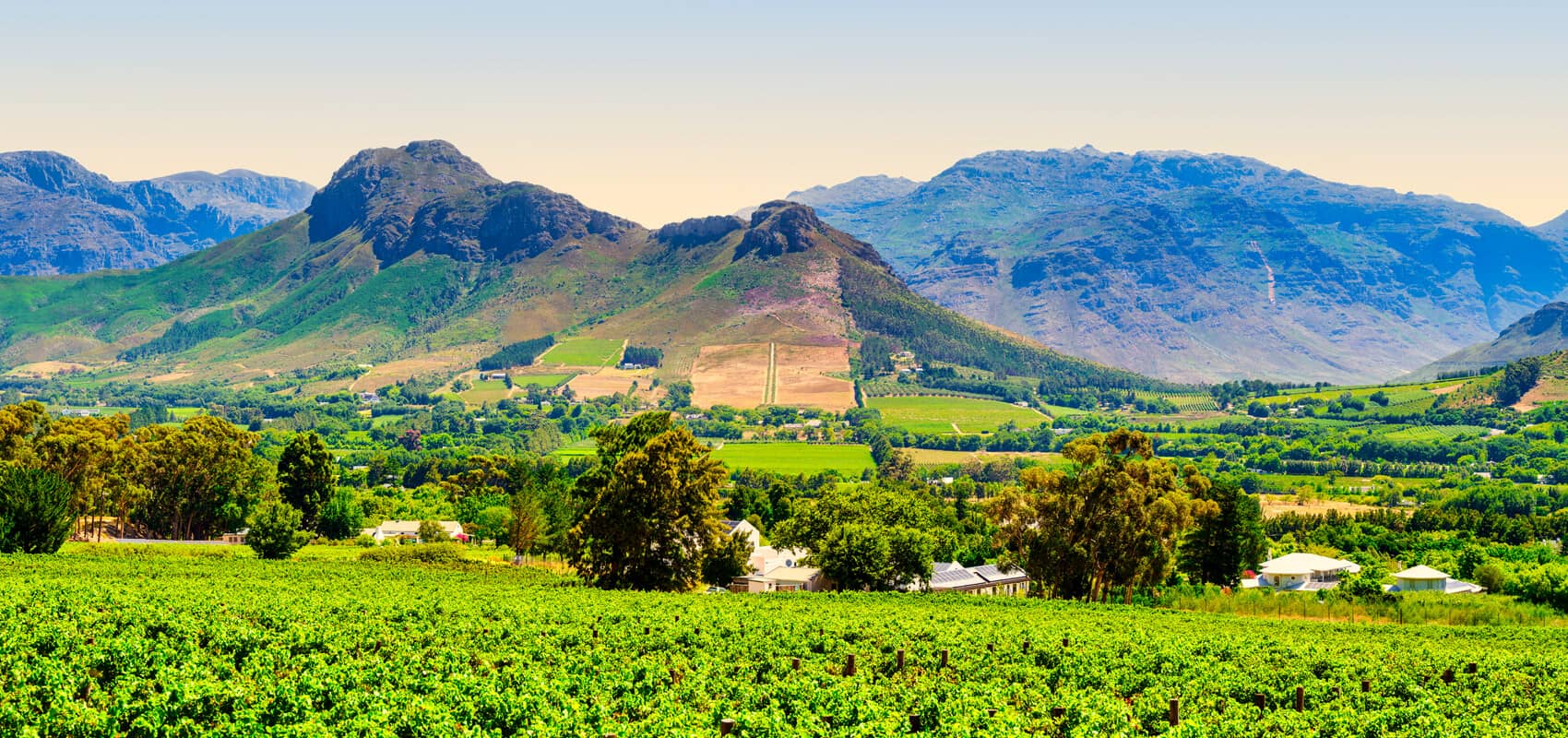 Franschhoek’s iconic vineyards stretching across the slopes.
Franschhoek’s iconic vineyards stretching across the slopes.
Helpful Links:
- Stellenbosch Wine Routes: Stellenbosch Wine Routes Official Site
- Franschhoek Wine Valley: Franschhoek Wine Valley Official Site
- Cape Winelands District Tourism: Cape Winelands District Municipality Tourism
- Delaire Graff Estate: Delaire Graff Estate Official Site
- Neethlingshof Estate: Neethlingshof Estate Official Site
- Babylonstoren: Babylonstoren Official Site
- Vergelegen Wine Estate: Vergelegen Wine Estate Official Site
8. R44 Scenic Route: Gordon's Bay to the Whale Coast
For a truly unforgettable road trip, take the R44, famously known as Clarence Drive. Considered one of South Africa’s most scenic routes, this spectacular 48km coastal drive stretches from Gordon’s Bay to Hermanus, hugging the dramatic coastline of False Bay. The road winds through mountains and valleys, offering simply breathtaking views of the ocean, beaches, and mountains at every turn. Numerous pullouts along the way allow you to safely stop, get out, and soak in the magnificent scenery.
 Stunning Views Along R44 Clarence Drive Gordon’s Bay Whale Coast.
Stunning Views Along R44 Clarence Drive Gordon’s Bay Whale Coast.
Coastal Gems Along the Way
The drive takes you past several charming spots mentioned in the video.
- Kogel Bay: Make a stop at this pristine beach, known for its stunning natural beauty, crystal clear waters, white sand, and dramatic cliffs.
- Rooi-Els: Nestled at the foot of Klein-Hangklip Mountain, this tranquil hidden gem is a haven for birdlife. Take a stroll to the Rooi-Els Lagoon to marvel at its pristine, clear waters.
- Pringle Bay: Another charming village you’ll pass through along this beautiful coastal route.
- Betty’s Bay: Continue to this charming seaside village, which offers stunning beaches set against a breathtaking backdrop of picturesque mountains. Nearby, you might consider a coffee break at the Arabella Hotel, overlooking its beautiful golf course.
Hermanus: Whale Watching Paradise
Clarence Drive culminates in the famous town of Hermanus. Each year (typically June to November/December), Hermanus transforms into a whale-watching paradise as Southern Right Whales arrive in its sheltered bay to calve and mate. Beyond the whales, Hermanus is a popular foodie destination with a wide variety of restaurants and cafes. The town embraces its whale heritage, evident in playful fountains, sculptures, and even street names. Enjoying a meal at a waterfront restaurant while watching the sunset over the Whale Coast is a perfect end to the drive.
Tips for Driving Clarence Drive
- Allow ample time to stop and enjoy the views – it’s not a drive to be rushed!
- Check the weather forecast; strong winds can occur along the coast.
- Use the designated pullouts for safety when stopping for photos.
- If travelling during whale season (approx. June-Nov), factor in extra time for potential whale spotting in Hermanus.
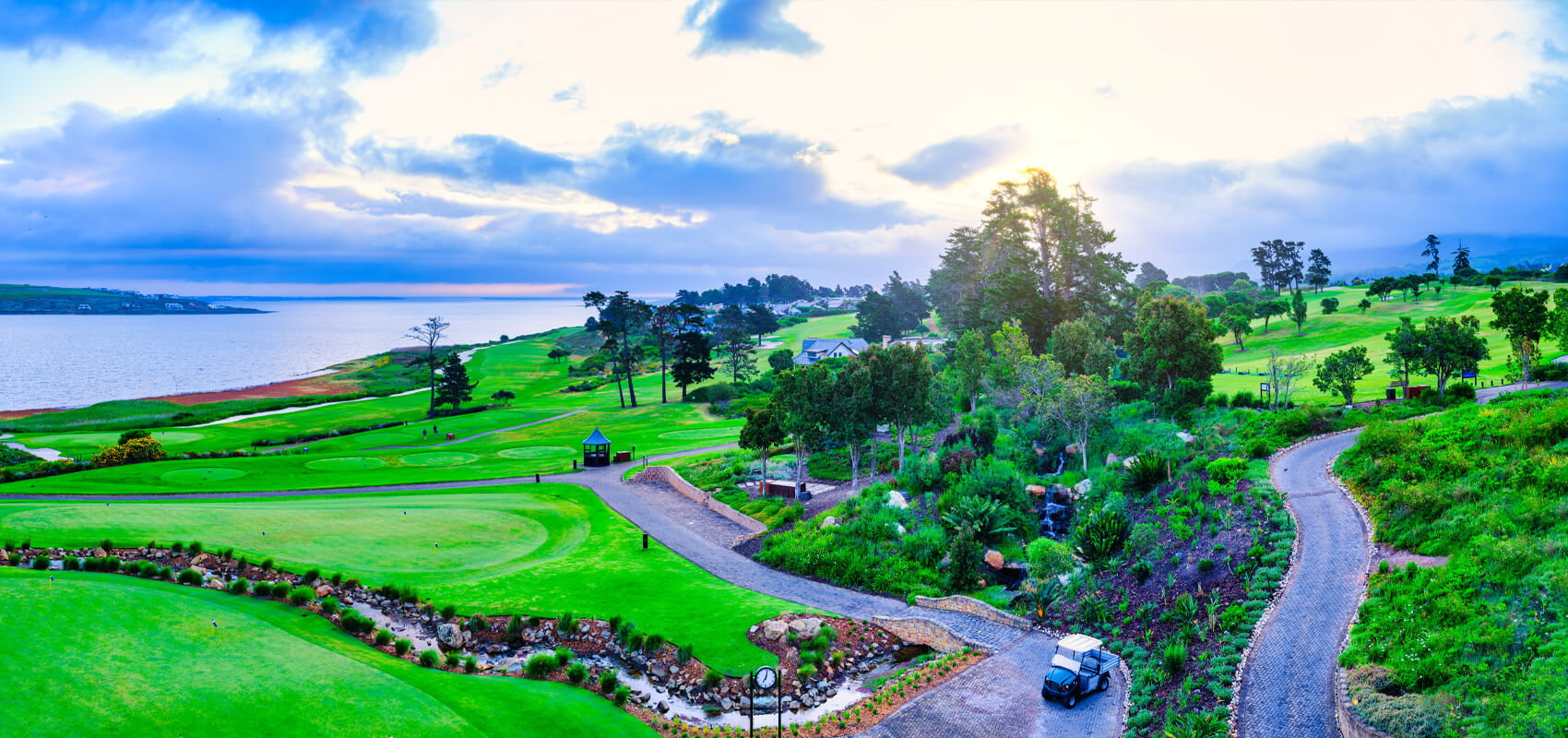 Arabella Golf Course Stunning Landscape Near Hermanus.
Arabella Golf Course Stunning Landscape Near Hermanus.
Helpful Links:
- Clarence Drive Info: Mountain Passes SA - Clarence Drive
- Gordon’s Bay: Gordon’s Bay Tourism
- Pringle Bay: Hangklip-Kleinmond Tourism - Pringle Bay
- Rooi-Els: Overberg Info - Rooi-Els
- Betty’s Bay: Hangklip-Kleinmond Tourism - Betty’s Bay
- Hermanus: Hermanus Tourism Official Site
- Kogelberg Biosphere Reserve: Kogelberg Biosphere Official Site
Frequently Asked Questions (FAQs) about Visiting Cape Town
Based on our detailed guide above, here are answers to some frequently asked questions to help you plan your Cape Town adventure.
1. What are the top must-do experiences in Cape Town?
Key highlights covered extensively include experiencing Table Mountain (by cable car or hiking safely), exploring the vibrant V&A Waterfront, taking the scenic Cape Peninsula drive (including Cape Point & Boulders Beach penguins), visiting the colourful Bo-Kaap, and potentially exploring the nearby Constantia Wine Region or broader Cape Winelands. The stunning Atlantic Seaboard beaches and the R44 (Clarence Drive) scenic route are also featured.
2. Is Cape Town safe for tourists? What are the main safety tips from the guide?
We advises exercising standard South African safety precautions. Key tips include: lock car doors and keep valuables out of sight (stow before arrival); be aware of your surroundings, especially in quieter spots or after dark; never hike alone on Table Mountain (use groups, check weather forecasts specifically for the mountain, carry ample water/map/charged phone, inform someone of your route); be extremely cautious of baboons on the Cape Peninsula (absolutely do not feed them, secure your car and all food items); check the operational status of Table Mountain Cableway (weather dependent) and Chapman’s Peak Drive before setting out.
3. How should I get up Table Mountain, and do I need to book?
You can take the Table Mountain Aerial Cableway (a ~5-minute ride in rotating cars) or hike one of the various trails (e.g., Platteklip Gorge, Skeleton Gorge). The Cableway operation is highly weather-dependent, especially regarding wind, so always check the official website. Booking Cableway tickets online in advance is highly recommended to avoid long queues. If hiking, prioritize safety: go in groups, be prepared for changing weather (layers/waterproofs), carry sufficient water and snacks, use a map, and consider a guided hike.
4. What are the highlights and essential tips for the Cape Peninsula drive?
This is described as a must-do full-day trip. Key stops include Muizenberg, Kalk Bay, Simon’s Town, Boulders Beach for the penguin colony (entry fee required, maintain distance), Cape Point within Table Mountain National Park (entry fee required, visit the lighthouse and southwesternmost point), and the scenic Chapman’s Peak Drive (toll road, check if open). Essential tips: Dedicate a full day, drive clockwise for best views, beware of baboons (aggressive if they see food - do not feed, keep car locked/windows up), lock car/hide valuables generally.
5. Do I need to book ahead for wine tasting in Constantia or the Winelands?
Yes, booking is essential or highly recommended for wine tastings, cellar tours, picnics, and especially for restaurants at the wine estates in both the nearby Constantia Wine Region and the broader Cape Winelands (like Stellenbosch/Franschhoek). Check individual estate websites for their booking procedures, particularly if visiting on weekends or during peak tourist season. Remember to plan transport if tasting (designated driver, tour bus, etc.).
From the majestic heights of Table Mountain to the vibrant V&A Waterfront, the stunning beaches of the Atlantic Seaboard, the wild beauty of the Cape Peninsula, the colourful streets of Bo-Kaap, the historic Constantia vineyards, the expansive Cape Winelands, and the breathtaking coastal roads like Clarence Drive – Cape Town truly offers an unforgettable blend of experiences.
We hope this guide, along with the accompanying video, has given you a taste of the Mother City’s magic, blending iconic sights with local insights and practical tips. Whether you’re seeking adventure on mountain trails, relaxation on pristine beaches, cultural immersion, world-class food and wine, or simply breathtaking scenery, Cape Town delivers.
Now it’s your turn to explore, discover your own hidden gems, and create lasting memories in this incredible corner of South Africa. Happy travels!
Our Photography Portfolio:
The photographs featured in this Cape Town guide were captured during the filming of our accompanying video. If you want to license these specific images, or explore thousands more from around the world that we’ve created over 14+ years, you can find our portfolios on major stock platforms below:
- Shutterstock: Shutterstock
- Adobe Stock: Adobe Stock
- Getty Images: Getty Images
- Depositphotos: Depositphotos


